Matador Network's Blog, page 1184
January 11, 2019
Flight attendant responsibilities

There are unwritten rules while traveling. One of those is, “Be kind and patient with your flight attendants.” Unfortunately, that’s not always the case. Whether due to flight delays, uncomfortable seats, lack of sleep, or just waking up on the wrong side of the bed that morning, sometimes this rule is forgotten.
A prime example happened recently when a flight attendant told a passenger they couldn’t walk to the front of the plane because pilots were passing in and out of the cockpit. In response, the passenger belittled her and told her, “you’re just a flight attendant.”
After the flight, the attendant wrote an open letter to the passenger in a Facebook post. Her message was something we can all learn from and keep in mind. In it, she details the extensive training required to be successful at her role, including learning how to identify guns, bombs, and other weapons. She also describes the intensive survival training all flight attendants go through to prepare for an emergency landing. Most poignant, however, she talks about some of her personal experience in the air, including comforting grieving mothers, holding babies while their parents are in the bathroom, missing countless holidays for work, watching a man die after CPR failed, and returning to work after 9/11.
She ends the note by imploring the passenger to “remember who is trained and willing to get you out of a crashed airplane, save you from hijackers, perform CPR on you if need be and — the easiest part of my job — give you food and drinks.”
Read the full post below:
“Dear Passenger in 5A, yesterday, when I wouldn’t let you come to the front of the airplane because the pilots were going in and out of the cockpit, you informed me I was ‘just a flight attendant.’ I’ve had some time to reflect on that and decided to educate you on a few facts regarding this flight attendant.
“First, let’s review my training and requirements for this job. I know how to fight fires while 35,000 feet in the air; I can perform CPR, do first aid-basic all the way up to inserting an IV; I know how to identify guns and weapons; I know how to identify bombs and then move them to a location on the aircraft that will hopefully cause the least damage should they go off.
“I know basic survival skills for land and water; I know how to disarm people brandishing a gun; how to actually kill someone if need be; how to prepare an airplane for an emergency landing so every person aboard has the best chance of survival, and how to then evacuate the aircraft in under 60 seconds.
“While smiling, I have been taught how to deal with people from many different cultures, people who are disgruntled, and people who are downright rude. I received excellent training for all these things and every year have to go through refresher training and learn new skills.
“Second, I’d like to share with you some of the personal experiences I’ve had in the last 20 years as a flight attendant. I’ve held the hand of a grieving mother who was flying across the country to claim her 21-year-old son’s dead body. I have given my personal clothes to a passenger who threw up, although I had nothing else to put on. I have been poked in my arm and sides many times by people who can’t wait for me to finish with one person before they get their drink.
“I have held babies while their parent went to the bathroom. I have been yelled at for not having the exact food a person wanted. I have prepared an aircraft for an emergency landing, and, while you were arguing with me about not wanting to turn off your computer, I was hoping I would be able to see my children one more time. I stood with tears in my eyes in the door of an aircraft while the remains of a US soldier were lowered in a flag-draped coffin. I have had the honor of flying US troops into foreign deployment areas. I missed Christmas Day with my family so you could get to your family. My work schedule is constantly changing, and there are times I go five to six days without a real night’s sleep.
“I watched the events of 9/11 in horror, heartbroken from what my colleagues went through that day. I was scared to go back to work, but I reassured my child that I would come home — all the while knowing it could happen again. I watched a man die in front of me, because the CPR we performed didn’t revive him. Then I tried to reverently place his body on the airplane floor for the remainder of the flight, and, when we landed, I sat with his body for over an hour until the coroner could pick it up.
“Please know that I do love my job, and I choose to do it. I have a college degree, am a mother, a grandmother, a friend, a human being. So the next time you look at me and think, ‘Just a flight attendant,’ I hope you quickly remember who is trained and willing to get you out of a crashed airplane, save you from hijackers, perform CPR on you if need be and — the easiest part of my job — give you food and drinks.” 
H/T: Forbes

More like this: Flight attendants confess things like sex on planes and watered-down drinks in a new survey
The post Passenger belittles flight attendant, who responds with moving open letter appeared first on Matador Network.

One dollar vacation deposits

This might be the best IOU you’ve ever written. Travel company Intrepid is offering dream trips around the world for just a $1 deposit. Obviously you’ll have to pay the full amount later, but the insanely cheap deposit could help thousands of people pull the trigger on trips they otherwise couldn’t afford. The small-group trips include Russia, cycling through the French Alps, Northern Italy, a Botswana safari, Everest Base Camp, and many more. Over 100 countries are included in the offer.
The goal of the deal is to encourage travelers looking to book the trip of a lifetime regardless of their current financial situation. It’s also likely to motivate solo travelers to partake in group trips (there’s an average of 10 travelers per trip). The trips are all led by local guides to give visitors a more authentic experience. A vast range of trip styles is available, from a few days to a few weeks and from younger age groups (18-29) to family-themed trips.
Intrepid started in 1989 and now arranges travel packages for 100,000 people around the world every year. The company has more than 1,000 organized trips to locations on every continent. The focus on small groups keeps costs more manageable than if you were traveling solo and planning everything out yourself, but it also means you’ll be going on your adventure with strangers (although they’re probably like-minded strangers).
Keep in mind, however, that most trips cost between $1,000 and $3,000, and you’ll be expected to cough it up eventually. Regardless of your time of booking, you’ll be required to pay for trips in full 56 days before departure. If you book your trip within the 56 days, payment will be due upon the time of booking. 
H/T: Insider

More like this: The 12 best budget destinations of 2019
The post You can book a vacation for a $1 deposit with this travel company appeared first on Matador Network.

Best pizza restaurants in Paris

Eating pizza in Paris may sound counterintuitive. France is known for its haute cuisine and fine wine, after all, and that cuisine is distinctly French, not Italian. Pizza isn’t on the list of iconic French food and wine pairings. Yet hitting the City of Lights without chowing down on a homemade pie is actually borderline sinful.
Despite being known for French pastries, bisques, baguettes, and boeuf bourguignon, France is very much a pizza-loving country. The French eat 22 pounds of pizza per person annually — the second most in the world after the US, which consumes 28 pounds per person annually. According to a study dug up by The Local, pizza is France’s number one comfort food. Paris, as the capital of France, is filled with just as much (if not more) pizza lovers as the rest of country.
Could it be the city’s proximity to pizza’s motherland? Or perhaps its longstanding history of all-around gastronomical goodness? Maybe. Regardless, all this dedication to pizza has led to some seriously good pizzerias in Paris that you need to schedule into your trip. So next time you find yourself in Paris, consider swapping comté and croissants for a solid slice.
Louie Louie

Photo: Louie Louie/Facebook
Located in Paris’ trendy 11th arrondissement, Louie Louie might just claim the title for best pizza in Paris. Louie Louie opened in 2015 and features a regular list of 16 different pizzas with daily rotating specials. No matter the pie, each one features fresh, seasonal ingredients. The restaurant’s warm wooden interior and minimalist decor add to the charm, and there’s a solid cocktail list to go with the slices. Louie Louie also wins out in terms of location. The neighborhood has a bustling natural wine scene, and Louie Louie is the perfect place to put something in your stomach before hitting Rue de Charonne’s many, many wine bars.
Ober Mamma

Photo: Ober Mamma/Facebook
Ober Mamma is owned by the Big Mamma Group, which has seven Italian restaurants. This is one pizza lovers need to pay attention to. The joint proudly owns two wood ovens — a rarity in Paris — each capable of firing up fresh pizzas at over 450 degrees Celsius (over 840 degrees Fahrenheit). The Pizza Middleton and white pizza are both to die for, especially when served up alongside an ever-flowing cocktail list that features punches, pisco sours, and various Italian amari. Be warned: snagging a spot at a place this popular doesn’t come easy. Plan to queue up for 15-40 minutes before chowing down.
Tripletta

Photo: Tripletta Belleville/Facebook
For the city’s most up-and-coming-pizza neighborhood, head to the 20th arrondissement. Located on the bustling Boulevard de Belleville, Tripletta first opened its doors back in 2016, serving up fresh, Neapolitan-style pizzas with soft crusts and a focus on fresh ingredients. Pizzas are split into four categories on the menu: cream, classic, tomato, and calzone, offering an array of options for varying levels of hunger. Desserts, cocktails, and beer on tap are also available. You won’t leave here hungry — and venturing out to the 20th is worth the trip for ‘za this good.
La Fabrica

Photo: La Fabrica/Facebook
On the Left Bank of Paris in the 14th arrondissement, there’s La Fabrica. Here, you’ll find an extensive list of Neapolitan-style pizzas and pasta served in a warm, hospitable environment. During warmer months, be sure to snag a seat outside underneath the red neon lights for people watching. The margherita pizza and capricciosa are your best choices, especially when washed down with a spritz (or two.)
La Briciola

Photo: La Bricola/Facebook
Even the historic Marais district isn’t left out of the pizza party. Whether lodging in one of the neighborhood’s chic hotels or simply shopping through the many boutique clothing stores, La Briciola is the perfect place to satiate early afternoon or evening (post 7:30 PM) hunger. Known for its white pizzas, appetizers, and massive meat calzones, La Briciola offers relatively affordable dining in one of the city’s more expensive neighborhoods. Although it’s usually packed, you likely won’t have to wait too long for a seat. A helpful note for tourists: The staff speaks English, French, and Italian. 

More like this: The 17 weirdest things people do to pizza around the world
The post Don’t eat French food in Paris, eat pizza appeared first on Matador Network.

January 10, 2019
Tips on travel to Antarctica
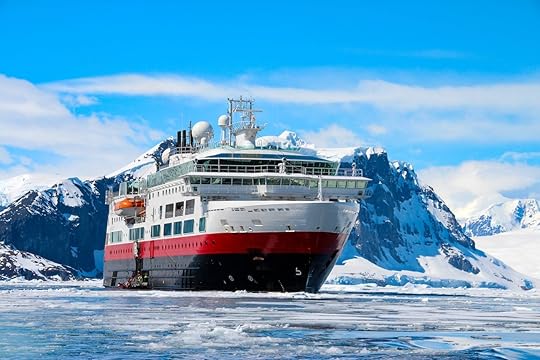
A mere hundred years ago, going to Antarctica was exclusively the realm of hardened, grizzled explorers who didn’t mind being away from home for years and losing a toe or three. Flash forward to 2019, and you’ve got ships with wine pairing dinners and butler service making dozens of trips there a year. Though getting there’s not cheap, the White Continent is now fully accessible to anyone who can afford it. But it’s still not as simple as taking a 10-day tour around the Caribbean.
Because Antarctica is truly like no place else in the world, there’s a lot you should know before going. Like how much it costs and how long it takes to get there. And if there’s WiFi. We had a chance to make the voyage aboard the Silversea Silver Cloud, and here are some helpful things to know if you’re considering a cruise to Antarctica.
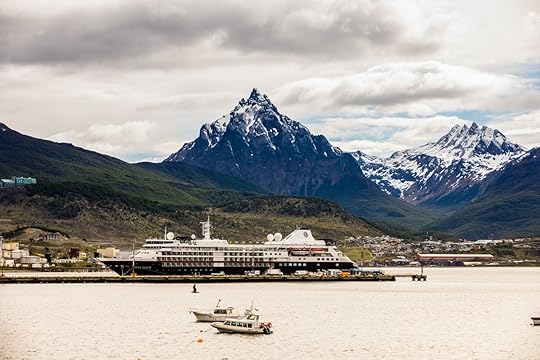
Photo: Laura Grier
1. It’ll take two days just to get to the port of departure.
Antarctica is a loooong way down there. You might have guessed this looking at a map, but the extent of how truly remote it is won’t hit you until you take a nine- or 10-hour flight to Chile or Argentina, spend the night there, then take ANOTHER three-to-four-hour flight to Ushuaia or Punta Arenas, Chile. This is before you even start the days-long journey to the northern tip of the Antarctic Peninsula. A weekend getaway this is not. Budget at least two weeks before you even look at cruises.
2. Cruises are long. And expensive.
Retrofitting a ship to navigate the most treacherous waters in the world isn’t cheap. And there are no economies of scale on a 200-passenger ship. So while getting to Antarctica isn’t the months-long journey only feasible for large governments that it was not long ago, it’s still a major investment of money and time. The average cruise costs in the neighborhood of $1,000 a day and runs anywhere from 11 to 18 days.

Photo: Laura Grier
3. You’ll spend a LOT of time at sea.
Again, and I can’t stress this enough, Antarctica is WAY the hell down there. So after you see your last spot of land in the Falkland Islands or South Georgia or somewhere else, you’ll likely go three hard days over the water before leaving the ship. Then, once you’re in Antarctica, it’s not like the port calls are full of seaside restaurants and duty-free jewelry shops. You’ll get a few hours off the ship, then it’s back on board for the rest of the day. What we’re saying is, pack some books and board games.
4. You’ll probably have WiFi, but it’s more like 36k.
With so many hours on the ship, a reasonable person in 2019 might think you could while away the hours binging on Netflix and video chatting with friends back home. That, of course, would be assuming you have a high-speed connection. The WiFi on the ships is usable, but it’s comparable to 1999 dial-up speeds. So while it’s a wonder of technology you can still answer emails at the bottom of the world, you’re not exactly gonna be streaming Narcos.
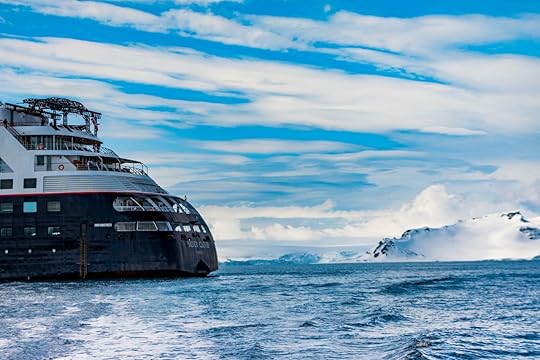
Photo: Laura Grier
5. Drake’s Passage is no joke.
The stretch of sea between the southern islands off South America and the northern tip of Antarctica is a lovely little channel known as Drake’s Passage. Named after explorer Sir Francis, not the guy who played Wheelchair Jimmy on Degrassi. Some days it can be calm as a lake. Some days it can have 20-foot swells. Most days it’s somewhere in between, but you’ll likely spend the better part of the 48-hour journey through it stumbling through the hallways of your ship like it’s the French Quarter at 4:00 AM.
The gym might be closed because weights fall off the shelves, and some food service might be limited if the seas are too rough. If you’re easily seasick, you will not be leaving your room for the duration of Drake’s Passage. Then you get to do it all again on the way back. Bring Dramamine and seasick wristbands.
6. You can only be on land for a few hours at a time.
Antarctica isn’t owned by any one country, but visitation is governed by the International Association of Antarctic Tour Operators (IAATO), which sets rules and regulations to preserve the continent. Among them is that only a certain number of people may be ashore at any one spot in Antarctica. This means you and your shipmates will go ashore in groups, and only for a limited time. This way everyone gets a chance to play in the snow and take penguin selfies, if only for a couple of hours. The downside is the ratio of hours traveled to time on land is probably the shortest of anywhere in the world.

Photo: Laura Grier
7. Color in Antarctica is all or nothing.
After a few days at sea you’ll really start to appreciate how excited pirates in those movies get when they spot a palm tree and yell, “Land, ho!” That first iceberg you see out your cabin window will be a marvel, and if the clouds stay overhead, you’ll spend your trip in an eerie black and white landscape of towering ice and steely water. However, if the sun comes out, it’s far more intense than it is up north and makes the sky and water a brilliantly intense blue. It also makes the snow a blinding white, and the specs of orange and red on the wildlife shine.
8. Antarctica takes cross-contamination very seriously.
Even though it might be tough for anything to grow in the harsh conditions of Antarctica, nobody is taking the chance. Before you set foot on Antarctic soil, all clothes you plan to wear ashore must undergo an agricultural inspection, ensuring you’re not inadvertently transporting any seeds or other organic life onto the continent. You also have to wear special boots that are only worn ashore and are kept in a separate changing room.
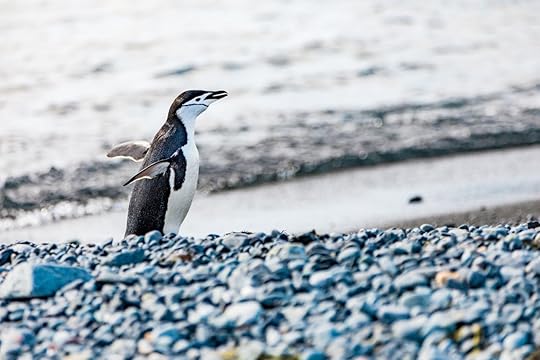
Photo: Laura Grier
9. Animals are not afraid of you.
Once ashore, you’ll encounter large colonies of penguins and sporadic seals lazing around the ice packs. Because they rarely see humans, they don’t fear us and as such will waddle or slide right up to you out of brazen curiosity. The general rule is to stay 15 feet away at all time, but if a penguin wants to follow you around, you don’t have to run.
10. By day four you’ll be sick of penguins.
The first day, they’re adorable. By day four you’ll be wondering why they all live on top of their own shit and will start complaining about the smell.
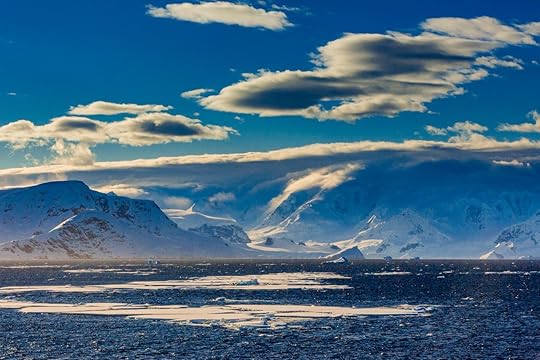
Photo: Laura Grier
11. Antarctica is full of mountains.
The vision many have of Antarctica is a little like North Dakota with penguins. Big, flat, barren, and snowy. But the mountains along the peninsula and the islands that surround it are breathtaking white peaks, like someone dropped the Andes in the middle of the ocean. The scenery is like nothing else, and even simply taking a Zodiac ride around the water is one of the most magical experiences in the world.
12. Your itinerary is flexible.
The weather in Antarctica can change in seconds. It’s a place where you wake up to perfect sunshine, and 20 minutes later you’re in the middle of a blizzard. This means you’ll get to do cool stuff like sail through frozen ocean, but it also means your schedule will never be certain. Your landing destination may be inaccessible due to ice or wind, and your Antarctic shore excursion might be replaced by an afternoon snowball fight on the pool deck. Odds are you’ll get to shore at least a few times, but it might not be as many as you’d hoped.

Photo: Laura Grier
13. You won’t be able to explore on your own.
As part of IAATO’s efforts to preserve the land and animals of Antarctica, guides mark very specific trails you must stay on when you land. This is done for a number of reasons, among them so you don’t leave deep footprints that unwitting penguins fall into. You’ll have plenty of space to hike around, but you will be with your shipmates the entire time. Privacy hours will have to be in your room onboard.
14. You may not step on mainland Antarctica… but it still counts!
Most Antarctic cruises take you to the Antarctic Peninsula, which if you look at a map of the continent is a little like Antarctica’s Florida. Like Florida, it has a number of barrier islands off the coast that are popular landing spots for cruise ships. Because weather sometimes prohibits mainland landings on the peninsula, you may only trek on the mountainous islands offshore. Some people think this means they haven’t really been to Antarctica and are disappointed they dropped the price of a Kia to only set foot on a barrier island. But you’d be hard-pressed to find anyone who’s been to Key West and said they didn’t really go to Florida.

Photo: Laura Grier
15. The water in Antarctica is insanely clear.
The current around the Antarctic Ocean is part of what causes those nasty waves in Drake’s Passage. It also does an extremely effective job of keeping all the crap in the rest of the world’s oceans away from Antarctica, which means the water is almost perfectly clear, so you can literally look down from your balcony onto penguins swimming alongside the ship and dolphins speeding right beside them.
16. It’s not as deathly cold as you think.
Granted, it’s not a tropical vacation. But Antarctica in summer isn’t terrifyingly cold either. If the sun comes out, you might even have days in the high 30s or low 40s. Colder days can drop into single digits. But it’s more like a bad day in Chicago than it is, say, winter in Siberia. Bring plenty of long underwear, winter clothes, and a good coat. But don’t fear the cold if you hail from somewhere warm.
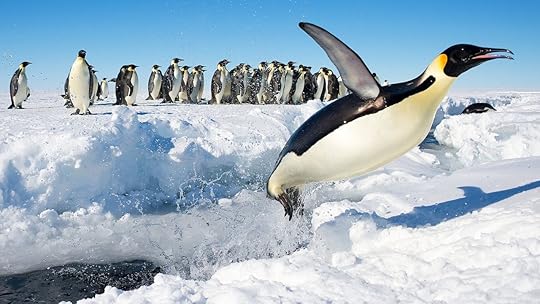
Photo: Cha Kar Pa/Shutterstock
17. You absolutely must do the “polar plunge.”
Most ships offer a “polar plunge,” where daring passengers can jump in the Antarctic Ocean for a few seconds from the side of the ship. Water is generally sub-freezing, and by the time you swim back to the ladder, you won’t be able to feel your feet. But it’s a once in a lifetime opportunity, almost-completely-safe with rescue rafts and medical personnel, and you’ll have a nice warm Jacuzzi to warm up in after.
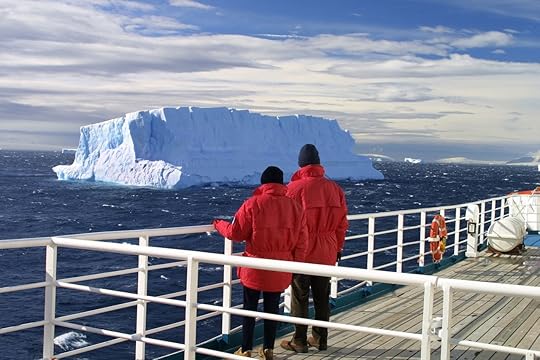
Photo: Christian Wilkinson/Shutterstock
18. If you’ve got the money, it’s absolutely worth it.
Despite the rough seas, limited time ashore, and spotty WiFi, going to Antarctica is the rare experience that can’t be compared to anything else. It’s the last truly wild place in the world, with no government, no society, and almost no contact with the outside world. It’s remote, extreme, and beautiful. And if you can afford the trip down, you’ll have no regrets coming back. 

More like this: Here’s what life is like aboard the most luxurious ship cruising Antarctica
The post 18 things you need to know before taking an Antarctic cruise appeared first on Matador Network.

Best places to travel this February
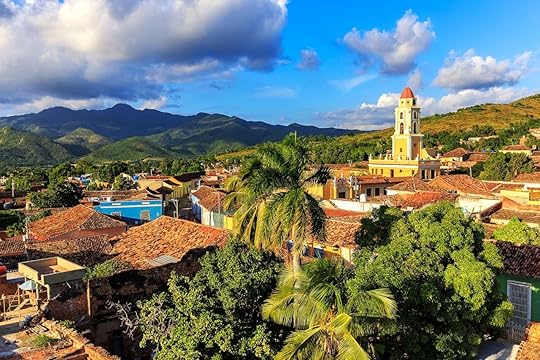
Though for much of the world February is the cold, barren home stretch of winter, it’s also one of the cheapest times of the year to travel since everyone is still feeling the burn in their wallets left by the holiday season. Well, what are a few extra hundred bucks on the Amex if it means killer flight deals and almost no crowds? While Carnival and Mardi Gras fall in early March this year, plenty of Carribean destinations will be kicking off their celebrations early in February, giving you a perfect excuse to escape to sunshine and rum cocktails in the name of “cultural immersion.” Not into sambaing? There’s also a lantern festival in Taiwan, the Mardi Gras of Mushrooms at a truffle festival in Oregon, and plenty of snowy activities in northern destinations if you’re not fed up with the cold yet. Sound exciting? Read on for the best places to travel in February.
1. Aruba
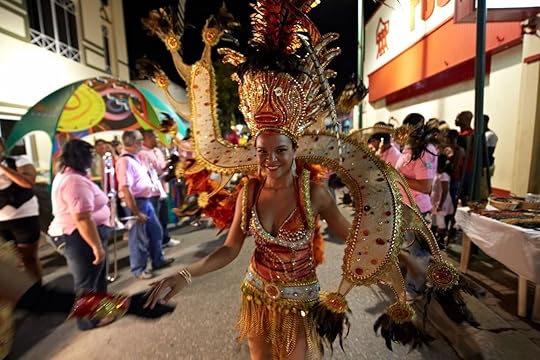
Photo: Aruba Marriott Resort
Winter escapes to the Caribbean are never a bad idea, especially during the first half of the year when the islands take turns hosting their unique, traditional Carnival celebrations. Aruba’s runs from the end of January to March 3 (that’s all of February, if you’re paying attention) with parades almost every weekend, colorful outfits, traditional music, and over-the-top floats. The added bonus of Carnival in Aruba is that you’ll have almost no chance of it literally raining on your parade as this desert island gets virtually no annual precipitation. And if you want to get up-close and personal with festivities, the Aruba Marriott has nightly private Carnival performances at its beachfront restaurant La Vista. Beyond the Carnival celebrations, Aruba is also one of the most badass Caribbean islands with outdoor activities ranging from desert ATVing to windsurfing.
2. Taiwan

Photo: Richie Chan/Shutterstock
In February, Taiwan is lit up as colorful lanterns fill neighborhoods, hillsides, and big public parks. The tradition dates back to the Qing Dynasty when remote villagers would retreat to the mountains to hide until after the winter solstice. Once it was safe to return, those left in the villages would light lanterns to alert their mountain-dwelling neighbors. Now the Lantern Festival is celebrated on the 15th day of the month before the Lunar New Year when nearly every city and town has a major celebration. The festival runs from February 19 to March 3, with the biggest displays during the Taipei Lantern Festival at Taipei Expo Park and the Kaohsiung Lantern Festival held along the Love River. Plus, Taiwan is one of our favorite destinations to travel to for 2019, so there will be plenty to do besides sending fire up into the sky.
3. Los Angeles, California
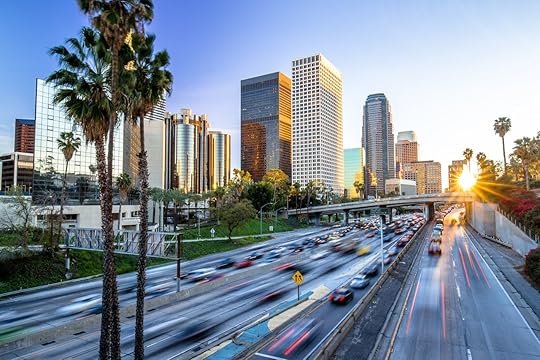
Photo: blvdone/Shutterstock
Being in Los Angeles during Awards Season is a little like being in Louisville for the Kentucky Derby. Or anywhere hosting the Super Bowl. Because even if you’re not among the lucky few to have tickets to the Grammys or Oscars, the parties and events surrounding them make you forget there even were award shows. If you’re not keen on finagling your way into Oscars events, you can still do fun, Hollywood-type stuff like take a tour of the Warner Brothers Studios and see all the props and sets from movies like Crazy Rich Asians or A Star is Born. Or you can post up at spots like Chateau Marmont and the London Beverly West Hollywood — home to the biggest hotel suite in LA — and wait for A-listers to roll in.
4. Vietnam

Photo: Chansak Joe/Shutterstock
Maybe you weren’t so big on New Year’s Eve this year and opted to stay home watching fireworks on television. No worries, the party is way better in Vietnam, where the celebration happens a whole month later, so you can give all your NYE-happy friends a healthy dose of FOMO. Tet is the Vietnamese New Year, celebrated February 4, and the week leading up to it leaves the normally chaotic streets of Hanoi and Ho Chi Minh City quiet and manageable. But once the families are done cleaning out their homes to freshen up for the new year, the country loses its collective mind — figuratively — when all-night parties and fireworks spectaculars fill everywhere from the beaches to the big cities.
5. British Columbia, Canada

Photo: Sam DCruz/Shutterstock
While the Canadian Rockies have become the go-to spot for exchange-rate-friendly winter sports, let’s not forget that British Columbia hosted the Winter Olympics nine years ago and still has some of the best slopes in the world. And this year, rather than simply rounding up a group of friends for a Canadian ski mission, you can take the insanity of The Yacht Week to the slopes when The Ski Week hits BC from February 9 to 16 and February 23 to March 2. You’ll fly into Vancouver then pile into an RV for a big, rolling party up the powder highway (Florida people, that’s not a euphemism). Along the way, you’ll hit three of the best ski areas in the country in Revelstoke, Sun Peaks, and Silverstar, sweating out your hangover from whatever you got into the night before.
6. Trinidad
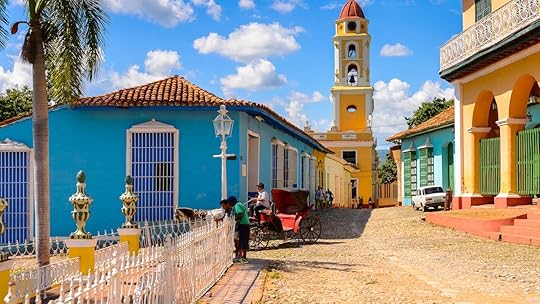
Photo: Anton_Ivanov/Shutterstock
So you want an all-out February bacchanal of humid sexuality and stuff you’ll never talk about later? Trinidad’s Carnival makes Mardi Gras look like a kindergarten birthday party. Caribbean people will tell you this is the biggest and craziest Carnival in the islands, a two-day nonstop party with back-to-back, 15-mile parades full of almost-naked dancers in feathered outfits gyrating to Soca music. The entire country shuts down for the duration of the celebration, which has been compared to the revelry in Rio but smaller and safer. Though it’s not for the faint of heart or alcohol tolerance, Carnival in Trinidad is an unforgettable experience. Though you may have to pace yourself if you’d like to remember any of it.
7. Botswana
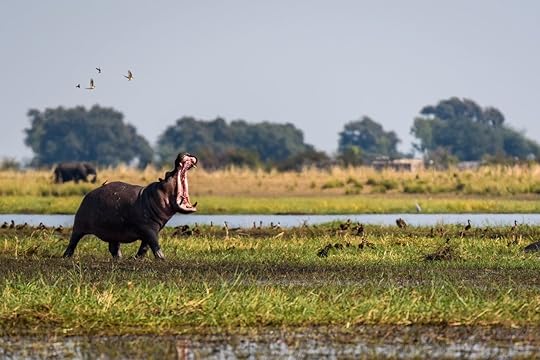
Photo: knelson20/Shutterstock
Ignore for a minute that February is low season in this relatively peaceful African nation, and you’ll save nearly HALF on everything from hotels to tours. It’s also the best time to go and spot animals there as it’s birthing season for antelopes, zebras, wildebeest, and other safari-worthy creatures. The good news is that you’ll see loads of adorable baby animals stumbling around. The other good news is that you’ll also see lots of predators like cheetah, lions, and leopards out looking for the young, easy prey. The bad news is that you may see said adorable babies mauled by said predators, but hey, what’s going to Botswana without a little live-action Animal Planet?
8. Antarctica

Photo: Earth Trotter Photos/Shutterstock
The window to visit the White Continent is short, but the best month within that window is February. While the weather is never a guarantee, you’ll have the best chance of catching the odd Antarctic sunny day when the water shines an otherworldly blue, and the white snow is almost blinding. Early February brings the hatching of baby penguins, and with 20 hours of daylight, you’ll also find the greatest abundance of wildlife out and about. Later in the month, you’ll have your best chance of spotting whales, an especially magical experience if done from your balcony aboard a luxurious Antarctic cruise ship, preferably in a plush, fluffy robe.
9. Willamette Valley, Oregon

Photo: Kathryn Elsesser
At first glance, February in the Pacific Northwest doesn’t seem all that inviting. But that’s exactly why Oregonians give themselves something to get excited about during these dreary months with the annual Oregon Truffle Festival on February 15-17.
Not merely a celebration of the culinary world’s fungal darling, this is Oregon’s premier food festival, where morning truffle hunts are followed by lunches at the Stoller Family Estate Winery by James Beard-nominated chefs. It continues with events like the Truffles and Bubbles Brunch — you can figure out what that entails — and the massive Newberg Fresh Truffle Marketplace, where you’ll sample fine Oregon wines, dine on truffle-infused bites, and even see truffle-dog demonstrations. Not into truffles? You’re not alone, but it’s still a perfect time to go wine tasting in the Willamette as the dreary weather keeps the crowds to a minimum.
10. Finland

Photo: Smelov/Shutterstock
No shortage of global options for northern lights viewing, but do all of them have a sauna gondola? No, no they do not. You’ll only find that at the Ylläs Ski Resort in Finnish Lapland, where the wooden tram lets you relax while you ride after a hard day of fat biking in Ylläs National Park. Though there’s never a guarantee of spotting the Aurora Borealis, you’ll still have a relaxing, romantic vacation staying at the Aurora Domes at Harriniva in clear igloos that let you catch the light show without leaving the heated comfort of your bed. Plus, since the holidays are over, you won’t catch the brunt of high-season pricing — which in Finland means everything goes from “prohibitively expensive” to just “pretty expensive.”
11. Jaisalmer, Rajasthan, India

Photo: OlegD/Shutterstock
In February, this medieval trading hub in the middle of the desert hosts one of the most outlandish festivals in the world, when the Desert Jaisalmer Festival goes down from the 17th to 19th. The festival begins with a colorful horseback procession from the stately Jaisalmer Fort to the Shahid Poonam Singh Stadium. The ensuing party goes on all day, highlighted by fire dancers, gymnasts, and folk music. The weekend continues with stuff like camel polo, camel races, turban-tying contests, a Mr. Desert competition, and the world-famous mustache contest where locals compete to see who has the longest one. It all culminates on Sunday with an air show and cricket match — and a majestic sunset over the Sam sand dunes at night.
12. Nevis
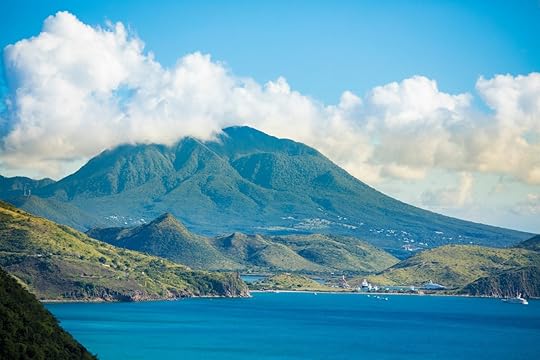
Photo: John Wollwert/Shutterstock
Hamilton Heads, look up. Because as of right now you can actually fly to the sunny, tropical “forgotten spot in the Caribbean” where Hamilton was born for less than top-tier seats to the show. And your trip will last longer than three hours. Where flights to St. Kitts and Nevis traditionally topped $800, this winter they’ve been at historic lows, with round trips dipping under $400 for the first time in recent memory. Once there, you’ll enjoy one of the most peaceful islands in the region, where daytime hikes up Nevis Peak give way to blissful afternoons along Nisbet Beach, one of the best crowd-free beaches in the Caribbean. Though you won’t find the place has turned itself into Hamilton Island, you can still visit the Alexander Hamilton birthplace, which disappointingly doesn’t charge $10 for admission. 

More like this: The 25 places you need to travel to in 2019
The post The best places to travel this February appeared first on Matador Network.

Joshua Tree National Park vandalism
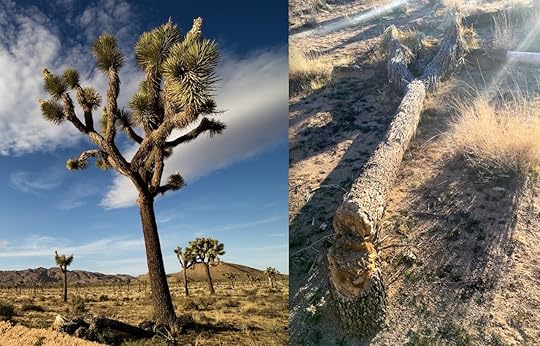
Vandals have been chopping down protected trees in Southern California’s Joshua Tree National Park during the government shutdown, so they can go four-wheeling across the sensitive desert landscape, said the National Park Service (NPS).
A photo of a downed Joshua tree taken by the NPS went viral after it was posted on Tuesday, prompting calls for the park to be shut down. The park has remained open during the government shutdown, but the lack of staff has meant people have been able to enter illegally and drive in restricted areas.

Photo: Joshua Tree National Park/Facebook
“While the vast majority of those who visit Joshua Tree National Park do so in a responsible manner, there have been incidents of new roads being created by motorists and the destruction of Joshua trees in recent days,” an NPS Tuesday press release read.
In addition to extensive off-roading, rangers reported seeing Christmas lights struck across the Joshua trees, a violation of park rules according to The Hill.
Although NPS announced on Tuesday it would close the park, by Wednesday the NPS said the park would remain open to visitors. In a Wednesday statement, the NPS said it was able to avert a park closure by using recreation fee revenue and Federal Land and Recreation Enhancement funds.
The NPS statement said the funds would be used to bring back maintenance crews to address sanitation and other issues that have arisen as a result of the government shutdown. Park entrances will be open, but park fees will not be collected.
The NPS statement also expressed “appreciation for the contributions of local volunteers…Their efforts have contributed significantly to the reopening of campgrounds and restoring access to other closed areas of Joshua Tree National Park.” 
H/T: The Hill

More like this: National parks are overflowing with trash and feces amid government shutdown
The post Vandals cut down Joshua trees so they could go four-wheeling during shutdown appeared first on Matador Network.

Study shows travel benefits students
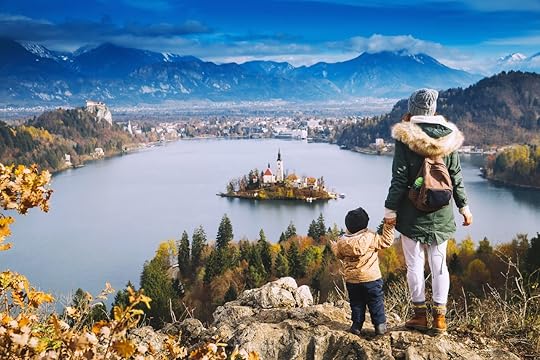
If you’re feeling guilty for taking your kids out of school for that family vacation, don’t. It might actually be making them smarter. According to a new survey commissioned by the Student and Youth Travel Association, travel has an extremely positive impact on students’ educational prospects, cultural awareness, and even their future careers. One thousand five hundred US-based teachers were polled in the survey, with 74 percent agreeing that travel has a “very positive impact on students’ personal development,” and 56 percent believing that that positive impact extends to a student’s educational experience.
The majority of teachers surveyed agreed that children who travel have an increased tolerance and respect for other cultures and a greater willingness to try new things. Teachers also observed that kids who traveled were more likely to demonstrate higher self-esteem, independence, confidence, adaptability, and sensitivity when interacting with other children. Unsurprisingly, a whopping 76 percent of teachers noted that once students had been taken on a single trip, they suddenly had the travel bug and expressed a desire to travel more.
Although no actual college admission statistics are provided to substantiate this belief, 42 percent of teachers said that they believe well-traveled students look more attractive to college admissions recruiters and are more like to be accepted.
A “well-traveled” student doesn’t necessarily mean the child has gone on an epic globetrotting trip to Asia. Impactful family travel can be as small as venturing domestically to a city or town vastly different from where the child grew up. Small, frequent weekend trips can be just as beneficial as a trip to Europe. 
H/T: Travel & Leisure

More like this: Family trips we love for 2019
The post Traveling with your kids makes them better in school, new study says appeared first on Matador Network.

Motorcycle tour of the Himalayas

Picture this: You’re cruising through the Himalayan high country, winding around tight mountain roads and crossing frosted rivers. Your fingers are gripping the handlebars, and a brisk wind is blowing, but you can’t help smiling and yelling “WHOOO!” This is a typical day on the Ride The Himalayas tour, a 15-day motorbike ride from the Indian city of New Delhi into the Himalayan high country that takes place three times each summer.
Ride The Himalayas founder and lead guide Rahul Yadav, a software engineer by trade, and his team take visitors on the ride of their lives through some of the highest roads in the world, visiting everything from lakes to monasteries along the way. It’s a challenging adventure and the most epic way to see the Himalayas. Equally important, it’s all-inclusive — all you have to do is sign up, show up, and try to quell that fear of heights.
The route
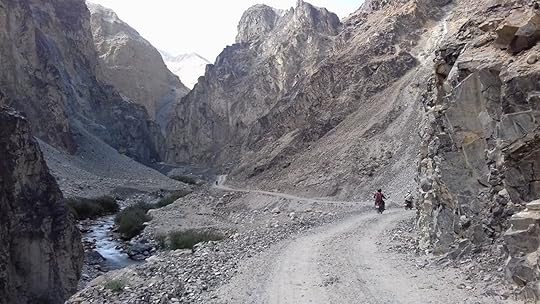
Photo: Ride The Himalayas/Facebook
Get ready to see the world’s highest mountains from, well, high up in them. This two-week-plus journey covers over 1,400 miles from New Delhi into the high Himalayas, finishing in the Kashmiri town of Leh. The summit of the journey lands riders atop the highest motorable highway in the world, known as Khardung La, and offers vistas as breathtaking as the fear-smashing ride it took to get there. Most days cover 100 miles, sometimes slightly more. Nights are spent camping, which means that every morning you’ll wake up to what is likely to be the best view of your life.
Departing from New Delhi, the first leg is in warm weather and flatter than the mountain passes, giving you time to get your bearings on the bike. There’s no need to be an expert rider when you show up. The guides walk you through the basics of motorbiking, and there are a few days of easier riding before the harder stuff. You then pass through the Spiti Valley and Manali-Leh Highway up to Khardung La on a trip designed to be both an outdoors adventure and a sightseeing journey.
You’ll cover most major tourist attractions along the way, including Pangong Lake, Tso Moriri Lake, Hunder Sand Dunes, and the Nubra Valley, along with the town of Diskit and a number of major Himalayan monasteries. Landscape-wise, the trip passes through lush green mountains and forests, barren mountain ranges, and the world’s coldest desert. In addition to being the most epic way to see the Himalayas, it’s also a test of your abilities to layer clothing and pack efficiently. Snow-packed roads make it a challenging ride at times — but, hey, that’s what the durable motorbikes are for.
The details

Photo: Ride The Himalayas/Facebook
If you’ve trekked to Macchu Picchu or done an organized backpacking trip elsewhere in the Himalayas, many of the basics are similar — aside from the fact that you’re on an off-road motorcycle instead of walking. A support staff accompanies the tour and prepares meals for the riders, and all of your lodging is taken care of. Trips run three times over the summer months. This year, departures happen June 3, July 8, and September 9, arriving in Leh approximately 15 days later. Because of weather and sightseeing, you should allow a maximum of 18 days for the journey as delays do sometimes happen. You may end up with a couple nights in Leh at the end, which you can use as the perfect opportunity to devour more momos (dumplings) and dal.
Book flights into and out of New Delhi. The tour operator will greet you at the airport and escort you throughout your stay. Depending on weather and other arrivals, you may stay a night or two in the city before departure. Be prepared for inclement weather; it’s the Himalaya, after all. Wind and snow are common, especially at higher elevations, and even though it’s summer, the daytime temperatures are likely to dip below freezing. Additionally, you’ll need a one-way flight from Leh back to New Delhi on the far end of the trip.
For riding gear, you are responsible for providing a riding jacket, kneecaps, gloves, and riding boots. These items can be rented or purchased in New Delhi or brought with you from home. The tour operator provides a helmet. Also, you rent one of the five different models of bike to ride on the trip from them directly. Backpacking gear is a good thing to bring, as well. A support staff accompanies the journey, including a mechanic with necessary tools and spares parts. The most staggering fact about this tour is the low cost. Bike rental, tour, food, and camping equipment and accommodations run in the ballpark of $2,850 per person. “This is a nonprofit initiative because we only charge the cost incurred to our members in managing the arrangement,” said Rahul.
Bookings can be made solo or in groups though no more than 15 riders are allowed on one trip. Five different motorbikes are available for rent. The two most popular, and most appropriate for the journey according to Rahul, are the Royal Enfield Classic 500 and Royal Enfield Himalayan. “The Himalayan is considered to be the best for the Himalayas, and it’s quite unique to ride,” Rahul said. If you head out with Rahul and his crew this year, along for the ride will be riders from Australia, Luxembourg, Canada, Finland, and the US. “People join us from across the globe every year. I just do it for my passion to be happy and to make others happy.”
What to know before you go
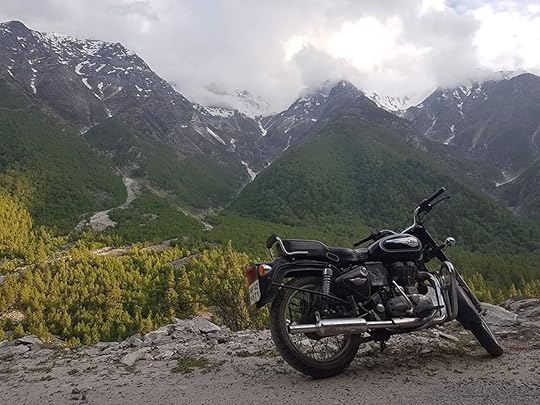
Photo: Ride The Himalayas/Facebook
First off, it’s important to understand where you’re going. While much of the trip is spent in the alpine, the end point of Leh is in the region of Jammu and Kashmir, an Indian state in the far north of the country. It’s generally safe, but you should be aware that for over 70 years Kashmir has been a centerpoint for near constant dispute between India and Pakistan with a bit of weight thrown around by China, as well. Local people are known to be quite friendly, and while you’re unlikely to be caught up in any political turmoil during your trip, you should have at least a basic understanding of what’s happened and why.
Another thing to remember is that a trip like this requires flexibility and an open mind. Mother nature may not always agree with the day’s plan. On top of that, you’re stuck with a group of people you’ve never met for over two weeks. Rahul emphasizes the importance of bringing a positive attitude and willingness to be malleable to the tour. He asks riders to be travelers, not tourists, and be open to trying new things. For further information and to contact Rahul Yadav, visit the tour’s Facebook page. 

More like this: This UK traveler is following in the footsteps of a legendary explorer to raise awareness for female travel
The post This motorcycle tour is the most epic way to see the Himalayas appeared first on Matador Network.

Eating raw chicken sashimi in Tokyo

When it comes to eating sashimi in Tokyo, fish is by far the most ubiquitous offer. But it’s not the only one. Restaurants also serve shikasashi (deer), basashi (horse), and — perhaps most hotly debated of all — torisashi (chicken). The name loosely translates to “raw bird,” and it’s exactly what it sounds like: thinly sliced raw chicken breast served with a flavorful salt or sauce.
I never thought I’d order raw chicken sashimi-style. Like most Americans, I grew up deeply terrified of salmonella, to the point that it became a personified monster. As a chef, I learned that undercooked chicken is a cardinal sin (I nearly failed a culinary school exam when I undercooked a chicken by three degrees Fahrenheit). But in Japan, a country with a palate for rawness, it seemed fair to give it a try.
In Japan, eating raw meat, fish, and eggs is just a part of the food culture, which values simplicity and reveres ingredients more than preparation. Tokyo, in particular, is famous for its food scene. The city itself seduced me as soon as I saw it from the plane: an enormous orange sun setting over a city that looked like seven separate New York skylines.
I went to dimly lit tempura bars, ate baby clams floating in a bowl of hot miso, and consumed thick tsukumen ramen (cold noodles dipped in broth) in a room silent except for the slurping. Then there was the cod sperm, sticky nattō (strong-smelling fermented soybeans), and raw eggs cracked over rice. Raw chicken didn’t seem all that strange in context surrounded by Tokyo’s many styles of restaurants.
Is eating raw chicken safe?

Photo: kan_khampanya/Shutterstock
The question of salmonella and campylobacter (another common raw meat bacteria) is a complicated one. Because salmonella lives in a chicken’s intestinal tract, careful slaughter and butchery are hugely beneficial in preventing the spread of salmonella. Still, food poisoning from raw chicken is far from rare. In the US, more than a million people get ill from salmonella annually. Salmonella is prevalent in Japan as well, and campylobacter is responsible for 60 percent of food poisoning cases in the country. High-end yakitori restaurants, however, take special care to source chicken clean enough to eat raw.
In fact, torisashi is a staple at Tokyo’s yakitori restaurants. Yakitoris are famous for skewers (particularly chicken) cooked over open-flame charcoal grills. You’ll find literally every part of the bird — gizzards, spleen, even three types of cartilage — and torisashi is just another way to showcase the meat. On menus, there are three options: torisashi (fully raw), toriwasa (broiled less than 10 seconds), and chicken tartare.
I first gave it a try at Toriyoshi, a basement yakitori joint in Tokyo’s Minato neighborhood. It was sliced thin, fanned out on a cold plate, and topped with grated ginger, shiso, and vinegar. The meat was soft, a bit sweet, and only lightly “chicken-y.” The texture is similar to raw tuna, and the subtle flavor of the meat is largely masked by the ginger. Sitting in a room surrounded by crowds of people slamming beers and sucking on half-cooked chicken thighs helped to soften, if not totally eliminate, my fear.
Torisashi comes from the chicken breast or tenderloin, the muscle furthest from the bird’s intestines, making it least likely to be infected with salmonella. Plus, yakitori chefs are meticulous to find the freshest, highest-quality meat. At most yakitori spots, the chicken is sourced from local farms and slaughtered almost immediately before it’s served. At Toriki, a favorite yakitori spot of the late Anthony Bourdain, chef and owner Kunio Aihara kills his chickens himself the morning before he serves them.
It’s obviously important to avoid eating raw chicken at home or anywhere unreputable. There’s one restaurant in the States that serves it: Ippuku, a highly acclaimed izakaya restaurant in Berkley, California, that serves a chicken tartare with raw quail egg. Other than that, stick to Japan. If you find yourself in Tokyo, these are a couple of spots to try raw chicken for the first time.
Note: A freshly killed and healthy bird that’s been properly processed and handled is much less likely to make you sick, but there are still risks involved. Anyone with a compromised immune system should avoid raw chicken, along with all raw meat, eggs, and fish.
Where to eat raw chicken sashimi in Tokyo
View this post on InstagramA post shared by JD (@my_foodie_safari) on Oct 22, 2016 at 5:23am PDT
Toriyoshi: This basement spot is a bit hard to find in the northern part of the Minato neighborhood. It’s a decent walk from the Hiro-o subway station but well worth the journey. Climb down a winding staircase and through a curtained door to a warm, crowded room where the chefs will yell “Irasshaimase” in unison and motion you to sit down. Sit at the bar if you can, and order everything. In addition to grilled and raw chicken, try the lotus flower and gingko nuts. There’s a great Japanese beer selection, too.
Toriki: This place was featured on Anthony Bourdain’s No Reservations in 2008, and it’s worth the hype. The chef still kills his own chickens and sources them from farms that raise their birds indoors, keeping the meat tender and helping to prevent disease. He specializes in toriwasa, lightly seared breast meat served with small dollops of wasabi. English menus are available, making it tourist friendly without feeling touristy.
Birdland: This is one of Tokyo’s Michelin-starred yakitori joints, right next door to Sukiyabashi Jiro in the Ginza subway station. It’s typically tasting-menu-only, but if it’s not busy they’ll let you order a la carte. A little on the pricey side but worth it for a splurge. 

More like this: What it’s like to eat the world’s stinkiest fruit for the first time
The post What it’s like to eat raw chicken sashimi in Tokyo appeared first on Matador Network.

Tappan Zee Bridge demolition events
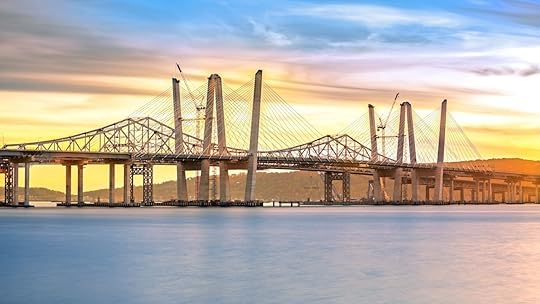
The Tappan Zee Bridge, which crosses the Hudson River about 25 miles north of New York City, is set to be demolished on the morning of Saturday, January 12. A series of explosives timed and placed for a graceful demolition will blow around 9:00 AM, dropping huge pieces of steel into nets strung above the river. And thanks to nearby restaurants, you can watch it all go down with a drink in hand and breakfast on the way.
Restaurants with views of the bridge are offering food and drink deals during demo day. And why not? People love to see the mighty fall. The Tappan Zee Bridge was built in the 1950s but was recently replaced by the Gov. Mario M. Cuomo Bridge, which runs closeby. The only thing standing in the way of the new bridge is all the remaining parts of the old bridge. But not for much longer.
According to a local news source LoHud, traffic will be stopped on the Gov. Mario M Cuomo Bridge at around 9:15 AM. At 9:30 AM, the explosives will go off and last “about a half-minute.” Traffic is expected to pile up in nearby Piermont as people watch, but go ahead and skip the crowd for some explosive breakfast.
Where to watch Tappan Zee Bridge demolition explosion
Pier 701 in Piermont: In a Facebook event, Pier 701 writes, “Join us 1/12/19 and witness history as they will be using explosives to demolish the Tappan Zee Bridge! We will be serving an all you can eat Breakfast Buffet from 8-11am for $22.95 per person!”
TWK Community Market in Piermont: Offering a special picnic basket with a choice of four sandwiches and also live streaming the event to watch while enjoying the restaurant’s breakfast menu.
Half Moon in Dobbs Ferry: Offering a “Big Bang Brunch” to “witness the demolition of what remains of the iconic Tappan Zee bridge.”
Sambal Thai & Malay in Irvington: In an event that quickly sold out, Sambal is offering a Dim-Struction Party with patio views of the demolition and mimosas from the bar.
Rivertown Taphouse in Piermont: Breakfast buffet from 8:00 to 9:30 AM that costs $20 without alcohol and $25 for Bloody Marys and mimosas. Also offered are special drinks to toast with, like the Jameson Breakfast shot complete with bacon and the French Toast Martini.
Bunbury’s Coffee Shop in Piermont: Selling a cookie called the Tappan Zee Bridge biscotti.
Hudson Farmer & The Fish in Sleepy Hollow: Beignets and coffee as well as the opening of the restaurant’s fireboat for viewing pleasure.
Red Bar Bakery in Irvington: Breakfast includes a Tappan Zee organic chocolate croissant and a Tappan Zee on eggs baguette with cheddar. 
H/T: Gothamist

More like this: The 7 restaurants in NYC with the best views
The post Restaurants selling blow-up breakfasts for the Tappan Zee Bridge demolition appeared first on Matador Network.

Matador Network's Blog
- Matador Network's profile
- 6 followers



